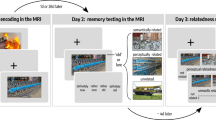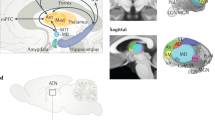Abstract
The dual-network memory model is designed to be a neurobiologically plausible manner of avoiding catastrophic interference. We discuss a number of advantages of this model and potential clues that the model has provided in the areas of memory consolidation, category-specific deficits, anterograde and retrograde amnesia. We discuss a surprising result about how this class of models handles episodic (“snap-shot”) memory — namely, that they seem to be able to handle both episodic and abstract memory — and discuss two other promising areas of research involving these models.
Access this chapter
Tax calculation will be finalised at checkout
Purchases are for personal use only
Preview
Unable to display preview. Download preview PDF.
Similar content being viewed by others
References
Ans, B., & Rousset, S. (1997). A voiding catastrophic forgetting by coupling two reverberating neural networks. Academie des Sciences, Sciences de la vie, 320, 989–997.
Ans, B., & Rousset, S. (2000). Neural Networks with a Self-Refreshing Memory: Knowledge Transfer in Sequential Learning Tasks without Catastrophic Forgetting. Connection Sciences, 12, 1,1–19
Cohen, J. J., & Eichenbaum, H. (1993). Memory, amnesia, and the Hippocampal System. Cambridge: MIT Press.
Frean, M., & Robins, A. (1998). Catastrophic forgetting and “pseudorehearsal” in linear networks. In Downs T, Frean M., & Gallagher M (Eds.) Proc. of the 9th Australian Conference on Neural Networks, 173–178, Brisbane: U. of Queensland
French, R. M., & Mareschal, D. (1998). Could Category-Specific Semantic Deficits Reflect Differences in the Distributions of Features Within a Unified Semantic Memory? In Proceedings of the Twentieth Annual Cognitive Science Society Conference. NJ:LEA. 374–379.
French, R. M. (1997a). Pseudo-recurrent connectionist networks: An approach to the “sensitivity—stability” dilemma. Connection Science, 9(4),353–379.
French, R. M. (1997b). Selective memory loss in aphasics: An insight from pseudo-recurrent connectionist networks. In J. Bullinaria, G. Houghton, D. Glasspool (eds.). Connectionist Representations: Proceedings of the Fourth Neural Computation and Psychology Workshop. Springer-Verlag. 183–195.
French, R. M. (1999). Catastrophic Forgeuing in Connectionist Networks. Trends in Cognitive Sciences, 3(4), 128–135.
Hebb, D. O. (1949). Organization ofBehavior. New York, N. Y.: Wiley&Sons.
Holland, J. (1975). Adaptation in natural and artificial systems. Ann Arbor, MI: The University of Michigan Press.
McClelland, J., McNaughton, B., & OReilly, R. (1995). Why there are complementary learning systems in the hippocampus and neocortex: Insights from the successes and failures of connectionist models of learning and memory. Psychological Review. 102,419–457.
McCloskey, M., & Cohen, N. (1989). Catastrophic interference in connectionist networks: The sequential learning problem. The Psychology of Learning and Motivation, 24, 109–165.
McNaughton, B., & Morris, R. (1987). Hippocampal synaptic enhancement and information storage within a distributed memory system. Trends in Neurosciences, 10,408–415.
McNaughton, B., & Nadel, L. (1990). Hebb-Marr networks and the neurobiological representation of action in space. In M.A. Gluck, & D. Rumelhart (Eds.) Neuroscience and Connectionist Theory. Hillsdale, NJ: LEA, 1–63.
Ratcliff, R. (1990). Connectionist models of recognition memory: Constraints imposed by Iearning and forgetting functions. Psychological Review, 97, 285–308
Robins, A., & McCallum, S. (1998). Pseudorehearsal and the catastrophic forgeuing solution in Hopfield type networks. Connection Science, 10, 121–135
Robins, A. (1995). Catastrophic forgeuing, rehearsal, and pseudorehearsal. Connection Science, 7, 123–146.
Robins, A. (1996). Consolidation in neural networks and in the sleeping brain. Connection Science, 8,259–275
Squire, L. (1992). Memory and the hippocampus: A synthesis from findings with rats, monkeys, and humans. Psychological Review, 99, 195–231.
Stickgold, R. (1999). Sleep: off-line memory reprocessing. Trends in Cognitive Sciences, 2(12),484–492.
Sutherland, G., & McNaughton, B. (2000). Memory trace reactivation in hippocampal and neocortical neuronal ensembles. Current Opinions in Neurobiology, 10, 180–186.
Traub R., & Miles R (1991). Neuronal networks of the hippocampus. Cambridge, UK: Cambridge Univ. Press.
Treves A., Rolls E. (1994) Computational analysis of the role of the hippocampus in memory. Hippocampus, 4, 374–391.
Vertes, Robert P. and Eastman, K. E. (2000). The Case Against Memory Consolidation in REM sleep. Behavioral and Brain Sciences, 23 (6).
Editor information
Editors and Affiliations
Rights and permissions
Copyright information
© 2001 Springer-Verlag London
About this paper
Cite this paper
French, R.M., Ans, B., Rousset, S. (2001). Pseudopatterns and dual-network memory models: Advantages and shortcomings. In: French, R.M., Sougné, J.P. (eds) Connectionist Models of Learning, Development and Evolution. Perspectives in Neural Computing. Springer, London. https://doi.org/10.1007/978-1-4471-0281-6_2
Download citation
DOI: https://doi.org/10.1007/978-1-4471-0281-6_2
Publisher Name: Springer, London
Print ISBN: 978-1-85233-354-6
Online ISBN: 978-1-4471-0281-6
eBook Packages: Springer Book Archive




